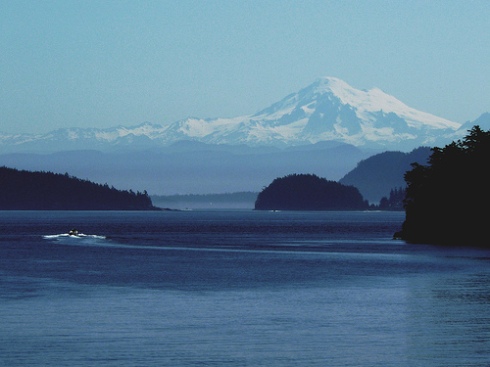A previous Ferrebeekeeper post described the largest living bivalve mollusk–the magnificent giant clam which is indigenous to the South Pacific. However there are other large bivalve mollusks out there which are nearly as remarkable (and possibly even stranger looking). One of these creatures, the geoduck clam (Panopea generosa), causes a unique amount of controversy, pride, consternation, and outright greed along the Northwest coast of North America where it lives
Geoducks are the largest burrowing clams in the world. Specimens weighing up to three pounds (0.5–1.5 kg) are widely known and 15 kilogram monsters are alleged to exist. Although the clams’ shells can grow quite large–sometimes exceeding 20 cm (8 inches) in length–the outstanding features of geoducks are their obscene siphons/necks which regularly reach 1 metre (3.3 ft) long (and can reputedly grow to twice that length). Thanks to these long necks, geoducks can bury themselves deep in the coastal sands while still filtering huge amounts of plankton rich water through their digestive system. . Geoduck (which is apparently pronounced “gooey duck”) is a word from the Lushootseed language, a tongue spoken by the Nisqually tribe. It means “dig deep” although the Chinese name for the clams “xiàngbábàng” (which means “elephant-trunk clams”) seems equally apt.
Geoducks of Wasshington and British Colombia do not have many natural enemies (although apparently in Alaskan waters they are preyed on by sea otters and dogfish). If left undisturbed, the bivalves can live to the fabulous age of a century-and-a-half. Lately however, the geoducks, which dwell in giant cold-water colonies beneath Puget Sound, are being gobbled up en masse by humankind. Although Anglo-Saxon settlers to the Pacific Northwest found the suggestive sight of the clams to be unbearable, the mollusks are hugely popular in China and Asia, where price can exceed US$168/lb (US$370/kg). Chinese diners believe that the geoduck’s…manly shape indicates that the unpreposessing mollusk will act as an aphrodisiac for those who consume its flesh. Price has shot upwards as China’s economy has grown.
In order to cash in on this bonanza, aquaculturists are attempting to stake out larger and larger swaths of coastline as geoduck farms. Such use of the tidelands causes consternation to real estate developers. Not only do developers object to the unaesthetic appearance of PVC pipes used as nurseries for juvenile geoducks, but the interests of both parties are entirely opposite. Coastal land development involves bulkheaded beachfronts, deforested land, and nitrogen waste from gardens and septic systems—all of which are inimical to successful geoduck beds.
 As the conflict rages on, some people (figuratively!) embrace the geoduck and its strange appearance for non-financial reasons. The Evergreen State College of Olympia, Washington has adopted the remarkable burrowing clam as a mascot. Although the school’s official seal features a conifer tree, the unofficial coat of arms features a geoduck rampant d’or on a rondel azure (or however you say that in heraldry speak). Additionally the school’s teams are all named the geoducks and they actually have a guy dressed up like a giant filter feeding clam to root for them.
As the conflict rages on, some people (figuratively!) embrace the geoduck and its strange appearance for non-financial reasons. The Evergreen State College of Olympia, Washington has adopted the remarkable burrowing clam as a mascot. Although the school’s official seal features a conifer tree, the unofficial coat of arms features a geoduck rampant d’or on a rondel azure (or however you say that in heraldry speak). Additionally the school’s teams are all named the geoducks and they actually have a guy dressed up like a giant filter feeding clam to root for them.





3 comments
Comments feed for this article
January 6, 2012 at 10:36 AM
Diana
Really glad I don’t have the geoduck as a mascot. Yikes.
January 8, 2012 at 10:39 AM
Wayne
USC is the world leader in the super manly mascot category and all other mascots probably seem watery and un-martial to you.
Personally I was always happy with the phoenix–androgynous symbol of immortal knowledge.
January 11, 2012 at 1:38 PM
Diana
Yeah the trojan on campus actually is performing a bodily impossibility — all of his muscles are tensed at once. Apparently one of the presidents’ wives made it while using the bodies of 3 football players as models. Ha.